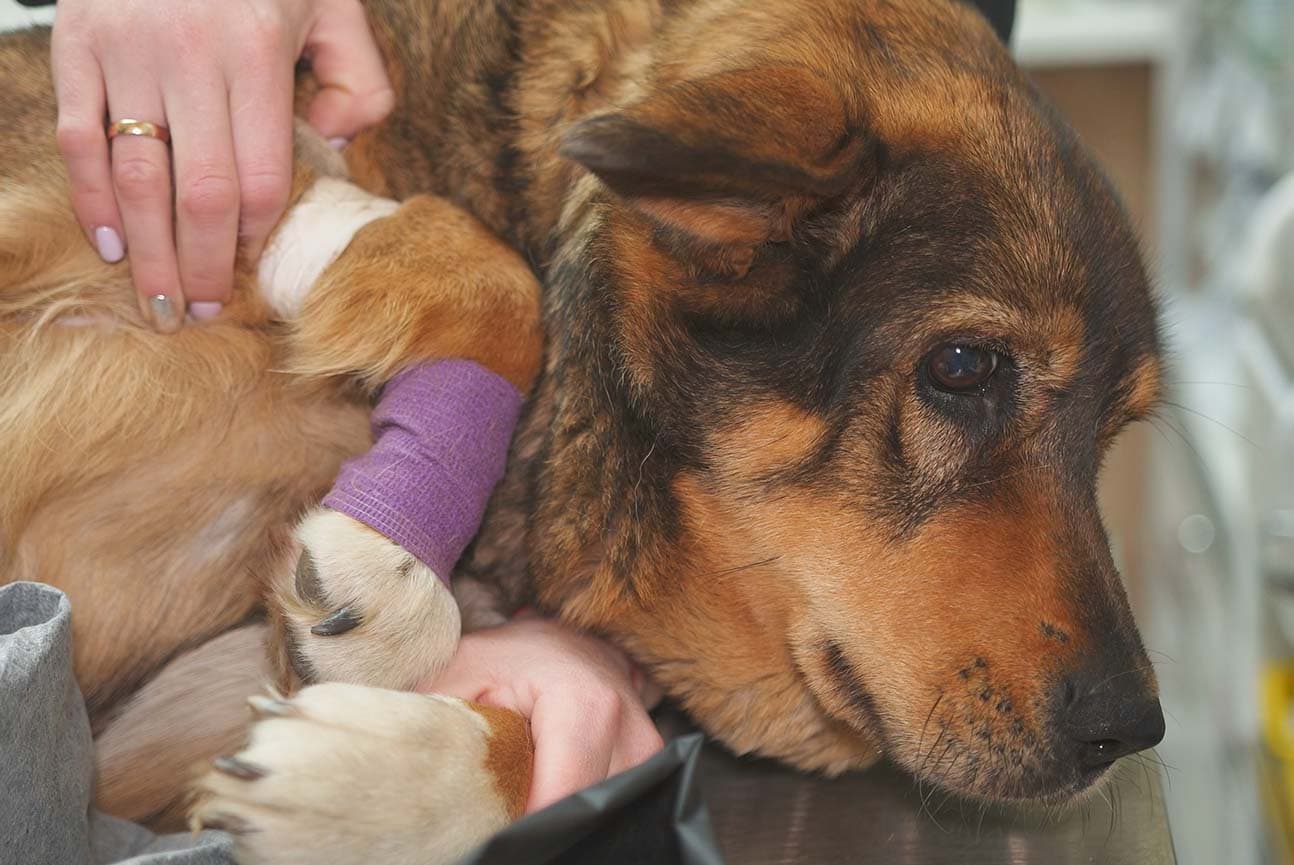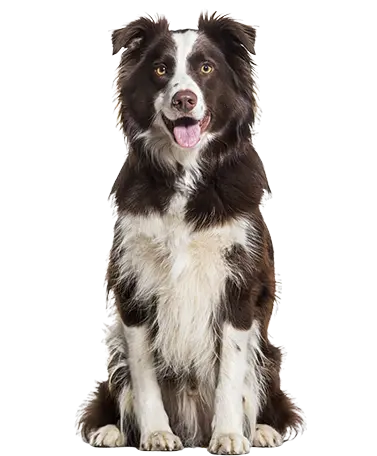Reviewed by Dr. Moustafa Hafez
Updated on 12/11/2025
Reading time 4 min.
Overview
Severity: Low
Life stage: All
Broken bones in dogs are serious injuries that require immediate veterinary attention. They can result from falls, road accidents, rough play or bones weakened by illness. While any dog can be affected, puppies, elderly dogs and small breeds are particularly vulnerable. A broken bone causes severe pain and immobility. Delaying treatment can lead to delayed healing and serious complications.
If you suspect your dog has a broken bone, keep them calm, avoid unnecessary movement and seek veterinary help right away.
What causes broken bones in dogs
Dogs can suffer broken bones (also called fractures) for numerous reasons, with the most common causes being falls, motor vehicle accidents, vigorous play and underlying health conditions, such as cancer, that weaken bone structure. In Dubai’s urban environment, dogs may face additional risks from high-rise apartments, busy roads, and the intense heat can cause weakness or disorientation, leading to accidents.
Not all impacts result in complete breaks. Bones can also suffer hairline cracks or become dislocated from their joints.
The most commonly fractured bones in dogs include:
- Hindlimb: femur (thigh bone)
- Pelvis
- Forelimb: radius and ulna (forearm bones)
- Skull
- Jaw
- Spine
What are the signs your dog has a broken bone?
Some fractures are immediately obvious, particularly ‘compound fractures’ where bone protrudes through the skin. However, many breaks are not visible externally, making it important to recognise the subtle signs of injury, especially after any accident or fall. And in Dubai’s heat, dogs may already be panting heavily, which can mask some pain responses.
Check your dog for the following key signs:
- Holding up the affected limb, refusing to place weight on it
- Displaying obvious signs of pain such as whimpering, trembling, or excessive panting (beyond heat-related breathing)
- Swelling around the injury site
- Showing reluctance to move or change positions
- Stopping eating due to pain and distress
- Exhibiting unusual aggression when touched. Pain can cause even gentle dogs to snap
Some dogs, depending on the fracture location and type, may still attempt to bear some weight on the injured limb, but this doesn’t rule out a serious break that requires immediate attention.
Are some dogs more prone to broken bones?
While any dog can suffer a fracture, certain factors are associated with increased risk:
- Certain breeds: Golden Retrievers, Greyhounds, Poodles, Pomeranians, and Chihuahuas are more prone to fractures.
- Size: Toy and small breeds have finer, more fragile bones.
- Age: Puppies (softer, developing bones) and geriatric dogs (weaker, brittle bones) are at greater risk.
- Bone health: Conditions like osteoporosis, cancer or poor nutrition weaken bones and increase fracture risk.
- Weight: Overweight dogs put extra strain on bones and joints, making breaks more likely.
In Dubai’s climate, smaller breeds may be particularly vulnerable as they overheat more quickly, possibly leading to weakness and falls. Additionally, many Dubai residents keep dogs in high-rise apartments, which can increase the risk of balcony falls if proper safety measures aren’t in place.
How do vets diagnose broken bones?
If your dog arrives at the emergency clinic with an obvious deformity or severe pain, the vets will first stabilise them and provide pain relief. Otherwise, the vet will start with asking about what happened (accident history) and carrying out a careful visual and physical examination to check for swelling, tenderness or abnormal movement. They will advise further tests:
- An orthopaedic examination: Hands-on assessment to pinpoint pain, swelling or instability.
- Imaging: X-rays are the gold standard to confirm and assess fractures; CT scans may be used for complex injuries (spine, pelvis, skull). Many Dubai clinics can provide same-day imaging.
These steps allow your vet to confirm the fracture, assess its severity and choose the best treatment plan.
What can be done to treat a broken bone?
Treatment options vary significantly depending on the location of the fracture, its severity and your dog’s overall health. Unlike human medicine, casts are rarely used in veterinary orthopaedics due to complications, such as poor compliance, bandage-related skin problems, joint stiffness and muscle wastage.
Most fractures require surgery to achieve the best outcome for healing.
Options include:
- Bone plates and screws for stable, long-lasting repair
- Long metal pins placed within the bone’s central cavity
- External fixation: lightweight frames attached to the bone with pins placed through the skin
Following surgery, dogs will be given appropriate pain relief and can begin walking within a few days. Your vet will usually schedule follow-up examinations 6-8 weeks post-surgery. This will include X-rays to check that the bone is properly healed before your dog resumes normal activity
Does a broken bone heal by itself in dogs?
Bones do possess natural healing capabilities, but allowing a fracture to heal without proper veterinary treatment carries substantial risks. Without appropriate stabilisation, bones may heal incorrectly (malunion), leading to permanent lameness, chronic pain and increased risk of arthritis later in life.
How to help your dog with a broken bone at home
Assisting your dog
During initial recovery, your dog will need help with basic movements. This support becomes particularly important on smooth marble or tile flooring, which can be slippery for recovering pets.
Consider investing in:
- Support slings for mobility assistance
- Non-slip rugs for commonly-used areas
- Ramps for accessing furniture or cars safely
Restricting activity
Proper confinement is vital for successful healing. Create a safe recovery space by:
- Restricting access to one carpeted area or using a large dog crate
- Installing baby gates to prevent access to stairs or balconies
- Removing opportunities for jumping onto furniture
- Providing mental stimulation, using puzzle toys to manage boredom during the long recovery period
- Using only short leads for essential toilet breaks
Physical therapy
Controlled movement helps maintain joint flexibility and muscle tone during healing. Physiotherapy services can provide professional guidance, but some techniques can be performed at home, under veterinary supervision:
- Cold therapy: Apply cold packs wrapped in towels during the first week to reduce swelling and provide pain relief
- Range of motion exercises: Gentle joint flexion and extension maintains joint health without interfering with bone healing
- Massage therapy: Once the initial inflammation subsides, gentle massage promotes circulation and provides pain relief
How to prevent complications after surgery
Surgical complications are uncommon, but can include infection, delayed healing or implant failure. Dubai’s warm, humid climate favours bacterial growth and may increase the risk of infection, making post-operative care particularly important.
Prevention strategies include:
- Strictly adhering to activity restrictions
- Keeping surgical sites clean and dry
- Following all medication schedules precisely
- Attending all scheduled follow-up appointments
When should you be worried about your dog with a fracture?
Contact your Dubai veterinary practice immediately if your dog:
- Has obviously broken a limb or been involved in a road traffic accident
- Refuses to bear weight on a limb and shows pain when touched
- Develops signs of infection around surgical sites: heat, redness, discharge, swelling, pain
- Becomes increasingly lethargic or stops eating
Modern Vet offers excellent 24-hour emergency veterinary services, so don’t hesitate to seek immediate help when concerns arise. For ongoing support and guidance throughout your dog’s recovery, professional veterinary advice ensures the best possible outcome for your pet’s return to full, active life in Dubai’s unique environment.
Worried your dog may have a broken bone? Don’t wait; fractures are painful and need urgent care. At Modern Vet Hospital in Dubai, our experienced team provides immediate pain relief, digital X-ray diagnosis, and advanced orthopaedic surgery when needed. From emergency stabilisation to ongoing recovery support, we ensure your dog gets the safest and most effective treatment. Modern Vet Hospital is Dubai’s trusted choice for compassionate, expert fracture care.
Share this, choose your platform!
Reviewed by
Dr. Moustafa Hafez
DVM
Dr. Moustafa graduated from the School of Veterinary Medicine in Egypt in 2012, advancing his expertise with an intensive internship in small animal surgery at Moscow State…


